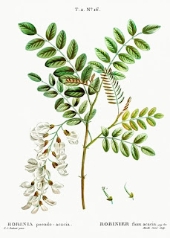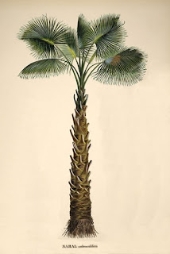
Robinia, Locust
Six varieties of Locust have been found useful in Herbal Medicine: Robinia fertilis - Bristly Locust, Robinia flava, Robinia luxurians, Robinia neomexicana, Robinia pseudoacacia - Black Locust, Robinia viscosa - Clammy Locust
Only Robinia pseudoacacia (Black Locust) is native to my region. Black locust is a very important tree in the Appalachian Mountains. Not only is it valued for timber and firewood, but fence posts made from Locust resist rot. Many homesteads would not have been possible without the Locust tree. One of the key characteristics of this tree is that, when cut, it will grow back – new shoots will come from the stump. Wise people coppice this tree, cutting it off at a certain height, so that firewood may be harvested from it repeatedly.
Resources of the Southern Fields and Forests states:
YELLOW LOCUST TREE; LOCUST; FALSE ACACIA, (Rohinia pseudacacia, L.) Grows in the mountains of N. and S. Carolina; vicinity of Charleston; collected in lower St. John's Berkeley, near Ward's plantation; Newbern. Fl. May. Dem. Elem. de Bot. The flowers are aromatic and emollient. An anti-spasmodic syrup is prepared from them; and Gendrin states that when given to infants, it produces sleep, vomiting, and sometimes slight convulsive movements; he relates a case where it was swallowed by boys, in whom acro-narcotic effects were induced. Mer. and de L. Diet, de M. Med. vi, 101 ; Desfont, Traite des Arbres, ii, 304; Ann. d'Hort. ix, 168; Ann. Clin, de Mont, xxiv, 68. Dr. Wood, in the 12th Ed. U. S. Disp., states that the bark of the root is said to be tonic, and in large doses, emetic and purgative, and he reports from the Ann. de Therap. 1860, p. 64, three cases of poisoning, in children, from eating the root; they all recovered; the symptoms were like those produced by an overdose of Belladonna. One of them who happened to be laboring under intermittent fever at the time, had no return of the paroxysm. He adds, "these facts render caution advisable in the use of the root, yet are also well calculated to stimulateinquiry." Mills states that "the best bows of the Indians were made of this tree."
King's American Dispensatory, 1898 tells us:
Chemical Composition.—From the root of this plant Hlasiwetz (1852) isolated asparagin. The flowers, according to Zwenger and Dronke (1861; see Husemann and Hilger, Pflanzenstoffe, p. 1046), contain a yellow, crystallizable glucosid, robinin (C25H20O16), which, upon hydrolysis, is split into quercetin and a non-fermentable sugar. The bark of the locust tree, when chewed, produced violent emeto-catharsis (Amer. Jour. Pharm., 1887, p. 153; F. B. Power and Jacob Cambier, Pharm. Rundschau, 1890, pp. 29-38). The latter authors, searching for the poisonous principle, found it in an albuminous body (phytalbumose, 1.66 per cent), which is tasteless, soluble in water, insoluble in alcohol, and coagulated by heat, with complete loss of its toxic properties; for this reason some declare a decoction of the bark is inert. It is precipitated by tannic acid and by solution of potassium bismuth iodide. It is allied to ricin, the poisonous, albuminous constituent of the castor-oil seed. (For further reactions, see the original paper.) The authors, in addition, found an inert albumin (globulin, characterized by being insoluble in concentrated salt solution); small quantities of the poisonous alkaloid, choline (of the class known as ptomaïnes), fatty matter, inert resin, cane sugar (4.57 per cent, referred to air-dry bark), starch, gum, some tannin, coloring matter, and probably asparagin. The poisonous principle, in the form of an albuminous body, was likewise obtained by R. Kobert (Jahresb. der Pharm., 1891, p. 146).
Action, Medical Uses, and Dosage.—A decoction of the bark of the root is tonic in small doses, but emetic and purgative in large ones. An ounce of the bark boiled in 3 gills of water, operates as a cathartic in doses of ½ ounce, given morning and evening. The bark is supposed to possess some acro-narcotic properties, as the juice of it has been known to produce coma and slight convulsions. An overdose has produced symptoms very similar to those resulting from an improper dose of belladonna, and at the same time cured a case of fever and ague. The flowers possess antispasmodic properties, and form an excellent and agreeable syrup. The leaves, in doses of 30 grains, every 20 minutes, operate mildly and efficiently as an emetic. The drug should be tested for its effects upon gastro-intestinal and nervous affections.
Plants for A Future states:
Medicinal use of Black Locust: Febrifuge. The flowers are antispasmodic, aromatic, diuretic, emollient and laxative. They are cooked and eaten for the treatment of eye ailments. The flower is said to contain the antitumor compound benzoaldehyde. The inner bark and the root bark are emetic, purgative and tonic. The root bark has been chewed to induce vomiting, or held in the mouth to allay toothache, though it is rarely if ever prescribed as a therapeutic agent in Britain. The fruit is narcotic. This probably refers to the seedpod. The leaves are cholagogue and emetic. The leaf juice inhibits viruses.
Peterson Field Guides Eastern and Central Medicinal Plants states:
American Indians chewed root bark to induce vomiting; held bark in mouth to allay tooth aches. A folk tonic, purgative, emetic. Flower tea used in rheumatism. In China the root bark is also considered purgative an emetic and the flowers are considered diuretic. Flowers contain a glycoside, robinin, which is experimentally diuretic. Warning: all parts are toxic dash even honey derived from the flowers is said to be toxic. The strong odor of the flowers has been reported to cause nausea and headaches in some persons.

Sabal Palmetto, Palmetto
Four varieties of Sabal have been found useful in Herbal Medicine: Sabal etonia - Scrub Palmetto, Sabal mexicana - Mexican Palmetto Synonym: Sabal texana, Sabal minor - Bush Palmetto Synonym: Sabal adansonii, Sabal palmetto - Cabbage Palmetto
Only one Sabal is native to my region, and that is the Cabbage Palmetto. This is the state tree of South Carolina, but also grows in coastal areas of North Carolina. It has historically been used as food, and for weaving baskets and hats, but I have found very little information on its medicinal use.
Plants for A Future states:
Medicinal use of Cabbage Palmetto: The berries or seeds have been used in the treatment of grass sickness, low fever, headaches and weight loss.
This article is an excerpt from The Medicinal Trees of the American South, An Herbalist's Guide: by Judson Carroll
His New book is:

Read About:
Medicinal Ferns and Fern Allies, an Herbalist's Guide
Southern Appalachian Herbs: Medicinal Ferns and Fern Allies, an Herbalist's Guide (Medicinal Plants of The American Southeast)
Available for purchase on Amazon:
https://www.amazon.com/dp/B0BMSZSJPS
His new cookbook is:

Read About The Omnivore’s Guide to Home Cooking for Preppers, Homesteaders, Permaculture People and Everyone Else"
https://southernappalachianherbs.blogspot.com/2022/10/the-omnivores-guide-to-home-cooking-for.html
Available for purchase on Amazon:
https://www.amazon.com/dp/B0BGKX37Q2
His other works include:
Medicinal Shrubs and Woody Vines of The American Southeast An Herbalist's Guide
Read about Medicinal Shrubs and Woody Vines of The American Southeast An Herbalist's Guide:
https://southernappalachianherbs.blogspot.com/2022/06/medicinal-shrubs-and-woody-vines-of.html
Available for purchase on Amazon:
https://www.amazon.com/dp/B0B2T4Y5L6
Growing Your Survival Herb Garden for Preppers, Homesteaders and Everyone Else
Read About Growing Your Survival Herb Garden for Preppers, Homesteaders and Everyone Else:
http://southernappalachianherbs.blogspot.com/2022/04/growing-your-survival-herb-garden-for.html
Available for purchase on Amazon:
https://www.amazon.com/dp/B09X4LYV9R
The Encyclopedia of Bitter Medicinal Herbs:
southernappalachianherbs.blogspot.com/2022/03/the-encyclopedia-of-bitter-medicina.html
Available for purchase on Amazon:
https://www.amazon.com/dp/B0B5MYJ35R
Christian Medicine, History and Practice:
https://southernappalachianherbs.blogspot.com/2022/01/christian-herbal-medicine-history-and.html
Available for purchase on Amazon: www.amazon.com/dp/B09P7RNCTB
Herbal Medicine for Preppers, Homesteaders and Permaculture People
southernappalachianherbs.blogspot.com/2021/10/herbal-medicine-for-preppers.html
Also available on Amazon:
https://www.amazon.com/dp/B09HMWXL25
Look Up: The Medicinal Trees of the American South, An Herbalist's Guide
http:///www.amazon.com/dp/1005082936
The Herbs and Weeds of Fr. Johannes Künzle:
https://southernappalachianherbs.blogspot.com/2021/05/announcing-new-book-herbs-and-weeds-of.html
Author: Judson Carroll. Judson Carroll is an Herbalist from the Blue Ridge Mountains of North Carolina.
His weekly articles may be read at judsoncarroll.com
His weekly podcast may be heard at: www.spreaker.com/show/southern-appalachian-herbs
He offers free, weekly herb classes:
https://rumble.com/c/c-618325
Disclaimer
The information on this site is not intended to diagnose or treat any disease or condition. Nothing on this site has been evaluated or approved by the FDA. I am not a doctor. The US government does not recognize the practice of herbal medicine and their is no governing body regulating herbalists. Therefore, I'm just a guy who studies herbs. I am not offering any advice. I won't even claim that anything I write is accurate or true! I can tell you what herbs have "traditionally been used for." I can tell you my own experience and if I believe an herb helped me. I cannot, nor would I tell you to do the same. If you use any herb I, or anyone else, mentions you are treating yourself. You take full responsibility for your health. Humans are individuals and no two are identical. What works for me may not work for you. You may have an allergy, sensitivity or underlying condition that no one else shares and you don't even know about. Be careful with your health. By continuing to read my blog you agree to be responsible for yourself, do your own research, make your own choices and not to blame me for anything, ever.


















